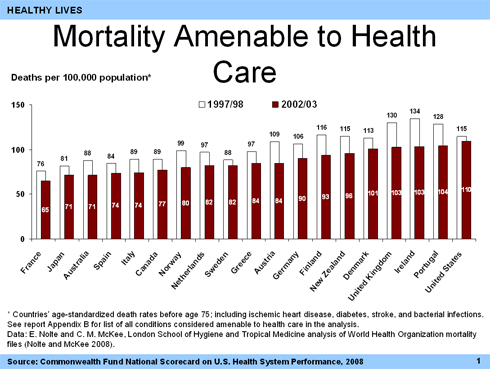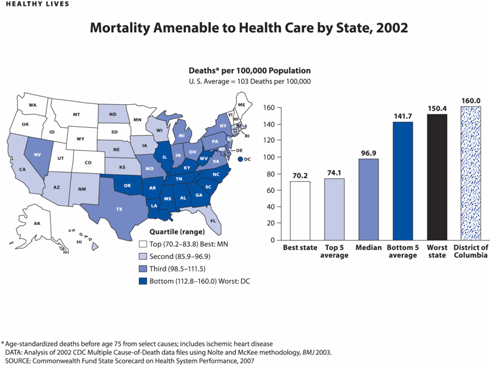By guest columnist Stephen C. Schoenbaum, M.D., M.P.H.
In its initial Framework Statement, the Commonwealth Fund Commission on a High Performance Health System stated that "a high performance health care system is one that has the overarching mission to help everyone live as long, healthy, and productive lives as possible…." But research from The Commonwealth Fund and others shows that the U.S. is not reducing its rate of "mortality amenable to health care"—or potentially preventable deaths—as quickly as other industrialized nations. And some recent studies point to disturbing declines in the U.S. on a related measure, life expectancy, as well as rises in infant mortality rates.
Poor performance on these measures points, in large part, to flawed preventive care—instances where the health system has failed to identify underlying conditions, such as hypertension, that can lead to potentially fatal diseases, or failed to help people with chronic disease stay as healthy as possible. For example, Fund research has found that, as of 2005, adults in the U.S. received only half of the recommended screening and preventive care for their age group.
Understanding the Differences in Rates of Preventable Deaths
On average across Organization for Economic Cooperation and Development (OECD) countries, mortality amenable to health care comprises about 23 percent of total mortality for men under age 75 and 32 percent of total mortality in women in this age group. It is a worthy target for reduction. Because of its significance, mortality amenable to health care was one of the measures of long, healthy, and productive lives used in the Commission's 2006 and 2008 National Scorecards on health system performance.
As Ellen Nolte, Ph.D., and C. Martin McKee, M.D., D.Sc., of the London School of Hygiene and Tropical Medicine reported in a Fund-supported study in Health Affairs, mortality amenable to health care in the U.S. dropped from 115 to 110 per 100,000 between 1997–1998 and 2002–2003. But the decline in other countries over the same period was greater—and the U.S. went from 15th to 19th in relative position among 19 developed countries in the OECD.

Within the U.S., there is tremendous variation on this measure. The Commonwealth Fund's State Scorecard revealed that, while some states have achieved results better than the top countries, others have results that are significantly worse than the national average.

Many people believe that differences in mortality rates simply reflect differences among the populations of countries or states, such as genetics or diet and lifestyle. Indeed, there is little question that measures of overall mortality are heavily influenced by factors other than health care. But the researchers measuring mortality amenable to health care minimize the influence of these factors by setting age limits. The measure includes only deaths under age 75, and is further restricted to deaths at younger ages for specific conditions, such as under age 50 for diabetes, 45 for leukemia, and 15 for conditions such as whooping cough. Researchers also adjust for the inability of medicine to prevent all deaths from certain conditions. For example, since evidence suggests that only up to half of premature deaths from ischemic heart disease (IHD) can potentially be eliminated by health care, the measure includes only half of the IHD deaths.
The measure may still reflect factors other than health care differences. But that said, the death rate from amenable causes among women under age 75 in 2002–2003 was 96.41 per 100,000 in the U.S., versus 68.15 in Canada and 57.40 in France. It appears that this is not the best we can do.
The Role of Disparities
Recent articles have drawn attention to other variations in mortality data within the U.S., in particular data on life expectancy that show increasing inequality among socioeconomic groups and geographic regions. The reasons for the inequality in life expectancy are not clear, though factors such as higher smoking and obesity rates, which contribute to chronic disease, have been cited. An April 2008 study on cross-county mortality disparities in the U.S. found that increasingly poor life expectancy in certain counties in the Deep South and Appalachia was caused by increasingly higher mortality from lung cancer, chronic obstructive pulmonary disease, and diabetes, among other non-communicable diseases. Christopher Murray, a coauthor of the study and director of the Institute for Health Metrics and Evaluation at the University of Washington, told the Wall Street Journal that, because chronic diseases are often preventable, this finding was both discouraging and encouraging.
Additionally, Centers for Disease Control and Prevention data reveal that the nearly decade-long decline in U.S. infant mortality rates has now stalled, a reflection of poor early prenatal care, among other problems. Most recent infant mortality rates are a little higher than in the past, and African-American newborns are 2.4 times as likely to die as white infants. While the link between race and infant mortality has not been established with certainty, poverty, poor access to health care, and dietary differences are likely to contribute.
A Need for High Performance
The data cited here underscore the need to implement health reform in the U.S. so that all Americans can have excellent access to excellent care.
The Commonwealth Fund's Commission on a High Performance Health System has developed five key strategies for achieving broad performance improvement:
- Extend affordable health insurance to all.
- Align financial incentives to enhance value and achieve savings.
- Organize the health care system around the patient to ensure that care is accessible and coordinated.
- Meet and raise benchmarks for high-quality, accessible care
- Ensure accountable national leadership and public/private collaboration.
First, we should make affordable care available to all by maintaining the employer-based system, as well as expanding public programs and offering health insurance through a national health insurance exchange. It is critical that Americans' health insurance be comprehensive, covering all necessary care, including preventive care, with little or no cost-sharing with individuals.
We also must reform our payment system, as fee-for-service incentives reward more services and not necessarily better care. Good preventive care, for example, requires not just a screening test, but also services that are not currently reimbursed such as outreach and follow-up when a test is positive.
Outreach and follow-up care are facilitated when patients have a medical home that serves as a regular source of care and coordinates care for people. Medical homes that are paid per patient can encourage preventive care by sending electronic reminders of screening visits—reminding patients that it's time for their cholesterol check, for example. We also should strengthen the quality of care offered by providers, particularly safety net providers, by ensuring they meet benchmark goals of performance.
Finally, national leadership is needed not only to establish prevention guidelines but to implement them better, develop incentives for creating and sustaining medical homes, and support better care with infrastructure such as health information technology. At that point, we can see whether we are able to catch up to the other industrialized countries that have long since passed us by in terms of outcomes such as amenable mortality, life expectancy, and infant death rates. Our poor performance on these measures should urge us to start work to improve health system performance as soon as possible.
The Commonwealth Fund is interested in your feedback. Please take advantage of our commenting feature by clicking on the "Post a Comment" button. Select comments will be published on this page.
Written with the assistance of Christine Haran.



